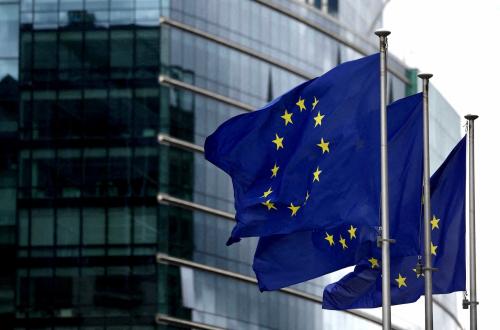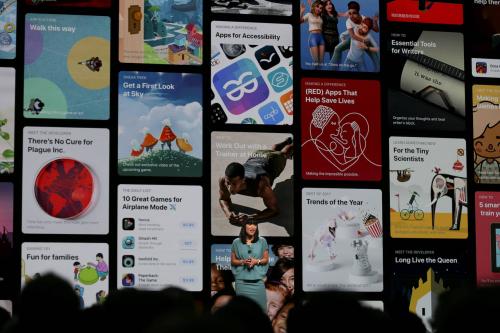In a previous TechTank blog, I suggested that the time might be ripe for regulating the prices that monopoly app stores can charge app developers. In this post, I want to take a deeper dive into how the European Union’s Digital Markets Act (DMA) is seeking to promote contestability and fairness in the mobile app industry.
The DMA approach does not avoid price regulation. Indeed, it explicitly requires designated app stores to provide access to app store facilities and services for developers on terms that are “fair, reasonable, and non-discriminatory.”
But in addition to this obligation for fair access and pricing, the DMA has many requirements intended to foster contestability in the app store industry. App store contestability, of course, means the existence of real companies competing with the incumbent app stores, not merely the possibility of entry. In this blog, I look at the DMA requirements, describe Apple’s recently proposed compliance measures, and assess the possibilities that this new regime will usher in a more open and vibrant app industry—one in which the dominant app store faces a real challenge that provides genuine choice for developers and users. Although Apple asserted at a hearing before the European Commission on March 18, 2024 that it made changes that complied with the law, it seems clear it will have to do more to provide for fairness and contestability.
The European Union’s DMA provides a system for promoting competition and protecting dependent businesses in core platforms services through ex-ante prohibitions and obligations. Instead of waiting for a company to engage in anti-competitive conduct and then bringing a competition case seeking changes in company behavior, the DMA allows the European Commission to designate companies as gatekeepers with respect to their provision of core platform services, thereby triggering the application of ex-ante pro-competition rules.
On September 6, 2023, the EU designated Google and Apple as gatekeepers with respect to the core platform services of mobile operating systems, mobile browsers, and app stores, thereby triggering the DMA’s prohibitions and obligations. Companies must comply with these ex-ante rules as of March 6, 2024.
As summarized by Yale University economist Fiona Scott Morton, the DMA provides measures for interoperability, disintermediation, and fairness, while allowing platforms to take steps to preserve the safety of the apps they offer. These measures apply to both Google and Apple as app store gatekeepers.
- Article 5(8) prohibits tying between the app store and the mobile operating system, so that the gatekeeper app stores cannot require app developers to distribute their product through the app store as a condition of allowing their app to work with their mobile operating systems.
- Article 6(4) requires the gatekeeper app stores to enable rival app stores to provide apps that use their operating systems and to allow users to select rival app stores as their default. An app store is a mobile app that has as its primary purpose the discovery and distribution of other apps.
- Article 6(7) requires equal access for rival stores to mobile operating system functionality free of charge.
- Article 5(4) allows app developers to communicate offers to users via their apps.
- Article 5(7) requires gatekeeper app stores to allow the use of alternative payment systems.
- Article 6(4) says that apps must be accessible by means other than the proprietary app stores. This could be done either through an alternative app store or through a link to the developers own website.
- Article 6(4) also allows gatekeeper app stores to take justified and strictly necessary and proportionate measures so that apps and app stores do not endanger the integrity of the operating system.
- Article 6(12) requires gatekeeper app stores to apply fair, reasonable, and non-discriminatory access to the store.
On January 25, 2024, Apple announced changes to its operating system and App Store in response to the new requirements in the DMA. These changes are accompanied, however, by restrictions and requirements that appear to frustrate the goals of contestability and fairness.
These changes allow alternative apps stores to install their products on iOS devices and to install their store’s apps on iOS devices. However, Apple also requires new app stores to provide a stand-by letter of credit from an A-rated financial institution—something which would be impossible for startups to do. Moreover, as made clear in its guidance for developers, Apple requires users to “download an alternative marketplace app from the marketplace developer’s website.” Apple’s own App Store is where most people would go to discover and download new apps. It is not clear why the rival app store app should not be available in Apple’s own App Store, except perhaps to make it harder for users to find.
Apple says these changes will allow so-called “sideloading.” But its initial guidance seemed to allow just downloading of apps from an approved app store, not directly from a developer’s website. On March 12, Apple clarified that it would allow authorized developers to distribute their apps directly from their website, through software that will be made available “later in the spring.”
Apple also requires notarization for all iOS apps, regardless of distribution channel. This is a “baseline review…focused on platform integrity and protecting users.” This notarization process appears to be a subset of the larger App Review process that also includes enforcement of Apple’s content and commerce policies.
While apps available on Apple’s own App Store will be reviewed under these content and commerce policies, it seems that apps available only on alternative stores will not be reviewed for these content and commerce policies. Since developers must provide the same app on all distribution outlets, this effectively means that the only way for a developer to avoid Apple’s content and commerce controls would be to give up distribution on the App Store. Consumers are thereby led to believe that an app available exclusively on alternative stores is likely seeking to evade these content and commerce policies and so might present greater risks to users.
Apple will also allow developers to use alternative payment service providers to link out to a website for payment, and to communicate offers within the app offered in Apple’s store. This capability comes, however, with a restriction. Developers may not “offer both In-App Purchase and alternative PSPs and/or link out to purchase to users in their app store app on the same storefront.” Developers must choose which payment system to use. They can offer payment through alternative payment system providers or outside links, or payment through Apple’s own In-App purchase system, but not both. It is not at all clear why developers—and their consumers—should not have both options.
Apple is also using what it describes as “safeguards” that could potentially keep consumers from using these alternatives. These include telling users that an app uses an alternative payment system, telling them when they are transacting with an alternative payment system and a review of apps to ensure accurate communication about alternative payment systems. Each of these steps provides Apple with an opportunity to send discouraging messages about the dangers of using a payment system other than the safe, secure system offered by Apple.
Apple is also proposing a new fee structure that could effectively make alternative app stores economically unviable. According to this new fee schedule, apps on the App Store will pay a commission of 17% on transactions for digital goods and services and there is a special 10% fee applicable to developers in Apple’s Small Business Program and subscriptions services after the first year. This compares with current rates of 30% and 15% respectively.
Apps on the App Store can use the App Store’s payment processing for an additional three percent fee. Since the typical charge for alternative payment services is around three percent, developers using payment alternatives will not experience any savings. They will pay around three percent regardless of whether they use an alternative payment system or the Apple system. The practical implication is that developers paying 30% today would pay 20% under the new system, Apple’s 17% commission plus a three percent fee for payment services.
While this may seem like a savings for developers and consumers, Apple then adds a new “Core Technology Fee” requiring apps to pay €0.50 for each first annual install per year over a threshold of one million installations. But this charge can mount up for apps with large distribution. For example, if an app is installed on 100 million Apple mobile devices in a year, then the app developer must pay Apple €49.5 million per year. This installation fee is particularly onerous for free apps or apps without in-app purchases. Under today’s rules, this developer would not pay a fee to Apple at all if there were no in-app purchases.
The installation fee applies to upgrades that take place after the first year of the first installation of the app. Since apps are constantly upgrading to improve functionally, this means that eventually developers with a huge installed base would have to pay the installation fee for every one of their current users as the upgrade fees kick in.
Apple estimates that more than 99% of developers would reduce or maintain the fees they owe to Apple under the new fee structure. It also estimates that less than one percent of developers would pay a Core Technology Fee on their EU apps. It concludes that “Only developers that have reached exceptional scale on iOS will be subject to the CTF.” This, however, is playing with statistics to possibly obscure an unfair practice. Only a very few of the 1.8 million apps available on the App Store become wildly popular, but their developers—and their consumers—will be hit.
Apple also creates a new choice architecture under which European developers will have the choice to remain with the current system and pay what they pay today, or to use the new capacities for alternative distribution and payment, in which case they pay according to the new fee schedule.
They make this choice by signing or not signing a special alternative terms addendum to their current developer agreement with Apple, which contains a clause preventing developers from going back to the old arrangement and fee structure once they opt for the new one.
Smaller developers paying a commission today might be tempted to move to the new system. Simply by signing the addendum, they reduce their commission for apps installed through the App Store—who wouldn’t want to pay 20% rather than 30%?
But the new installation fee creates a disincentive for popular apps with large distribution to sign the addendum, especially if they do not sell the apps or digital services through the app. Their installation fee would be enormous—almost €50 million for companies with 100 million downloads. They will stay with the old terms to avoid this crushing burden. Even smaller app developers that hope one day to grow would probably stay with the old system, even with its higher commission fees, since there is no going back to the old system without the installation fee.
The purpose of drawing out Apple’s response to the DMA is to interrogate how companies may be able to function around the required measures, which means that the larger intentions of the rules may not be realized. For the purposes of contestability, the key question is whether Apple’s fee structure and choice architecture create enough of an incentive for potential developers of alternative app stores to enter. It seems plain that few, if any entrepreneurs or established businesses, would risk confronting Apple with a rival store under these conditions.
One exception appears to be Epic Games, the maker of the “Fortnite” franchise, which has engaged in a long-running feud with Apple over its distribution practices, including a court case in the U.S. that it mostly lost. When, despite the disincentives built into Apple’s new rules, Epic sought to establish a developer’s account to sell its games on Apple’s App Store and to build its own independent app distribution platform, Apple terminated the account, arguing that Epic Games could not be trusted to act in good faith. After an inquiry from the European Commission, however, Apple relented and restored Epic’s developer account. Whether Epic can create and maintain a viable alternative store in the face of this hostility remains to be seen.
Apple’s new structure should also be assessed under the new DMA requirement for fairness, reasonableness, and non-discrimination that apply to app stores and to other companies labeled as gatekeepers of core platform services. Allowing existing developers who have no interest in the new capabilities to maintain their current arrangement seems fair, but huge installation fees for apps that do not charge anything seems unreasonable.
FRAND (fair, reasonable, and non-discriminatory) is not just an acronym. It is a pricing methodology that has been used extensively in litigation involving standard essential patents. When a standards development organization includes the technology of a patent holder in a technology patent, the patent holder commits to licensing its technology on FRAND terms. Royalty disputes often arise between the patent holder and a company wanting to implement the standard. In the extreme, these cases are settled through lengthy and expensive court proceedings. The European Commission is looking at reforms in this area to make litigation more efficient and fairer. There are several methods available to courts to settle these disputes, but it has not been settled what methodology courts should use in settling these disputes. It is also not clear how the Commission would use these methodologies in the context of Apple’s access terms and fee structure.
It is clear from this brief case study that whether a contestable and fair arrangement for app developers will emerge from the DMA depends on the access and fee structure Apple is allowed to put in place. The Commission must make this call. Like it or not, it is in the business of supervisory regulation, including price regulation. It could allow the new fees and other arrangements and see how the industry develops. But it could also disallow them—both as unfair and as undermining the conditions for contestability.
Companies that include Microsoft and Meta have been critical of Apple’s proposals and have asked the Commission to disallow it. A group of developers and trade associations has written an open letter to the Commission complaining that Apple’s proposals “make a mockery of the DMA.” The letter says Apple’s choice architecture is “unworkable” and presents a “false choice” between staying with the current system or moving to the new one, neither of which, it says, is DMA compliant. It points out that few developers will accept the new terms that are “financially unattractive.” Several economists, including Yale’s Fiona Scott Morton, published a paper through the European Centre for Economic Policy Research finding that the new terms will “block entry and innovation in app stores.”
In response, Apple has modified its new proposal. But the revisions do little to mitigate the defects of the new system. An alternative app store can now avoid the requirement for a letter of credit, but only if it has been an Apple developer for at least two years and has an app that had more than one million first annual installs on iOS in the EU in the prior calendar year. Once again start-ups are excluded. Apple now allows a developer that signed the addendum (likely to get the lower commission rate) a one-time opportunity to revert to the original terms (likely because its installs have triggered the new installation fee). But to use this opportunity, the developer must never have applied to run an alternative store or used an alternative store or payment system. Once again, Apple is creating a huge disincentive for the emergence of alternative app stores.
To date, the European Commission has already taken strong measures against Apple’s conduct in the operation of its App Store. On March 4, 2024, it fined Apple over €1.8 billion for abusing its dominant position in the distribution of music streaming apps. It found that Apple’s rule preventing developers from telling users about cheaper ways to get music subscription services was illegal under existing EU antitrust rules. Apple says it will appeal the ruling.
Both under the DMA and under this new antitrust ruling, Apple must allow developers to communicate cheaper offers to their users. Since Apple’s proposed compliance with DMA would require Spotify to sign the prohibitively expensive new terms to do this, Spotify now wants the Commission to require Apple to allow these communications, without the new terms, as part of compliance with the new antitrust ruling.
The European Union adopted the DMA in order to improve its ability to reign in tech. It would be ironic indeed if now the Commission allowed Apple to do something to comply with the DMA that it forbids under existing antitrust law. To avoid this disheartening result, it must carefully review Apple’s proposed DMA compliance plan to ensure that it provides for contestability and fairness. With Apple as a case study into the potential conflicts between the requirements of the DMA, and corporate response, only time will tell how these issues pan out.
A contestable market is one that is genuinely contested, not merely one in which a new entrant might appear. Trust in the magic of “potential” market competition is misplaced. Back in 2019, as the movement for revitalizing digital competition policy was picking up steam, Jason Furman, former head of the U.S. Council of Economic Advisors, now at Harvard, rejected this potential competition approach, saying, “Ensuring that competition is vibrant requires ensuring that there are competitors.”
One measure of success under the DMA would be the emergence of durable rival app stores, able to provide new channels of app distribution that give both users and developers genuine choices. It seems reasonably clear that durable app stores will not emerge under Apple’s proposed DMA compliance plan.
It is nevertheless important to be clear-eyed about the project of promoting app store competition. The natural tendency of incumbents to resist new entrants might not be the only force blocking the development of competition. This key digital industry might very well be a natural monopoly where supply-side economies and network effects might prove to be unremovable even with fullest use of pro-competitive tools.
But if so, not all is lost. If an industry is a natural monopoly, then, as Lina Khan said in the law review article that made her famous before her ascent to the chair of the Federal Trade Commission, it would be appropriate to apply elements of public utility regulation including non-discrimination rules and continued price regulation to “limit how a monopoly may use its power.” The mobile app infrastructure is a central, core digital industry that needs to be under public supervision if actual competition fails to develop. Even a durable app store monopoly can be prevented from abusing its business customers or leveraging its monopoly into another dominant position in adjacent markets.
What is clear is that any hope of instilling competition into the monopoly app industry will require vigilant and often intrusive supervisory regulation. Incumbents rarely give up their incumbency without a fight. When their rivals must depend on dominant company platforms to compete fairly, there is an almost irresistible incentive for incumbents to game the system to preserve their current advantages. Regulation must assume such an incentive and take active and alert steps against it.
In the United States, such intrusive regulation is seen as the opposite of effective antitrust policy. In Europe, regulation is seen as a complement, not a substitute for competition policy, which seems the better approach.
The way forward is for European regulators to exercise their powers to the fullest in what might be an uphill battle to create and maintain competition in the app industry. For the U.S., the message is also clear. A regulatory structure focused on promoting and facilitating competition in digital industries must supplement existing antitrust tools.
-
Acknowledgements and disclosures
Google, Microsoft, and Meta are general, unrestricted donors to the Brookings Institution. The findings, interpretations, and conclusions posted in this piece are solely those of the author and are not influenced by any donation.
The Brookings Institution is committed to quality, independence, and impact.
We are supported by a diverse array of funders. In line with our values and policies, each Brookings publication represents the sole views of its author(s).








Commentary
Overseeing app stores to promote competition in the Digital Markets Act
March 20, 2024